
The stock market serves as a crucial indicator of economic health, reflecting the collective sentiment of investors regarding the future performance of economies, sectors, and individual companies. Understanding the trends in stock markets can provide invaluable insights for investors, policymakers, and economists.
Let’s delve into the factors that indicate the rise and fall of stock markets globally, with specific references to the New York Stock Exchange (NYSE), the Indian stock market (NSE and BSE), and the Nepali share market (NEPSE), supported by relevant examples.
Bull and Bear Markets
Stock markets show cyclical patterns, often called bull and bear markets. A bull market is characterized by increasing stock prices over a specific period, impressive rising economic indicators, and increased investor confidence. Conversely, a bear market involves falling stock prices, typically due to economic downturns, negative investor sentiment, geopolitical uncertainties and government financial policy.
Key factors influencing stock market trends
Economic Indicators: Economic performance indicators, such as GDP growth, employment rates, inflation, and interest rates, significantly impact stock market trends.
Corporate Performance: The financial health and performance of companies, including Fiscal reports, revenue growth, and management quality, play crucial roles in stock price determination.
Geopolitical Events: Elections, wars, trade disputes, and political instability can cause significant fluctuations in stock markets.
Market Sentiment: Investor psychology, including fear and greed, speculative trading, and market cycles, influences market trends.
Global market trends: NYSE and Indian Stock Market
The New York Stock Exchange (NYSE) is one of the biggest and most influential stock exchanges in the world, serving as a barometer for global economic health. Several key trends and events have shaped the NYSE’s history and the backbone of global market indication.
The Great Depression (1929-1939): The stock market crash of 1929 led to a decade-long economic depression, with significant declines in stock prices.
Post-War Boom (1949-1966): Following World War II, the U.S. experienced a prolonged economic expansion and technological innovation, driving a sustained bull market.
Dot-com Bubble (1995-2000): The rapid rise of internet-based companies led to inflated stock prices, followed by a severe market downturn when the bubble burst. Microsoft, IBM, Intel, Oracle and Cisco were the market giants. During that period apple was about to bankrupt. In 1990 Apple’s price was $0.22 per share and in 2000 Its share price ranked at $0.27 per share almost for 10 years Apple’s stock price remained almost the same. Whereas in 1990 Microsoft shares were trading at around $0.55 through the decade Microsoft’s stock price rose steadily with the success of Windows operating software. In 2000, the stock price reached $53.60 per share which was a remarkable increase of 58000% in a decade.
2008 Financial Crisis: The collapse of the housing bubble and subsequent financial turmoil caused a global recession, with the NYSE experiencing significant declines. During this period, Subprime mortgage crisis, a credit crisis bank collapse and a government bailout.
COVID-19 Pandemic (2020): The pandemic led to a sharp market decline in March 2020, followed by a rapid recovery due to unprecedented fiscal and monetary stimulus measures. A certain rise was observed in the Indian and Nepali stock markets.
The Indian Stock Market (NSE and BSE)
India’s stock market, represented by the National Stock Exchange (NSE) and the Bombay Stock Exchange (BSE), is one of the fastest-growing markets globally. Key trends and events include:
Liberalization Era (1991-Present): Economic reforms in the early 1990s opened up India to foreign investment, leading to significant growth in the stock market. It was a great financial decision by Manmohan Singh Indian Prime minister.
IT Boom (2000s): The growth of the IT sector and increased foreign investment drove a sustained bull market.
Global Financial Crisis (2008): The Indian stock market experienced significant declines due to the global financial crisis, followed by a recovery driven by strong domestic economic fundamentals.
Demonetization (2016): The Indian government’s move to demonetize high-value currency notes led to short-term market volatility but was followed by long-term growth.
COVID-19 Pandemic (2020): The pandemic caused a sharp decline in Indian stock markets in early 2020, followed by a rapid recovery due to fiscal stimulus and robust economic growth.
Nepali Share Market (NEPSE)
The Nepal Stock Exchange (NEPSE) is a smaller and relatively young market compared to its global counterparts. Despite its size, which shows similar trends influenced by various factors:
Economic Factors: GDP growth, inflation, and remittances significantly impact the NEPSE index Central bank policy and interest rates on the Market are likely to influence the stock market.
Political Stability: Political uncertainties and frequent changes in government can lead to market declines, while stability boosts investor confidence.
Banking Sector Performance: The banking sector constitutes a major portion of the NEPSE index, making its performance crucial for the overall market.
Foreign Investment: Increased foreign investment and remittances boost the market, while declines have the opposite effect.
Comparative Analysis: NYSE, Indian Stock Market, and NEPSE
NYSE
GDP Growth: The U.S. economy’s performance is a critical driver of the NYSE. Periods of strong GDP growth, such as the post-war boom, have led to sustained bull markets.
Employment Rates: Low unemployment rates, indicative of economic health, boost investor confidence and drive stock prices higher.
Inflation and Interest Rates: Moderate inflation and low interest rates are conducive to market growth. High inflation or rising interest rates can lead to market declines, as seen during the 1970s stagflation.
Indian Stock Market: GDP Growth: India’s economic reforms and high GDP growth rates have driven significant market growth, particularly in the IT and services sectors.
Inflation and Interest Rates: The Reserve Bank of India’s monetary policy plays a crucial role in influencing stock market trends. Low inflation and favourable interest rates have historically supported market growth.
NEPSE
GDP Growth: Economic performance directly impacts the NEPSE index. For example, the NEPSE saw significant growth between 2014 and 2016, driven by economic expansion and political stability.
Inflation and Remittances: Moderate inflation and high remittance inflows boost consumer spending and investment, positively impacting the stock market.
Corporate performance
NYSE:
Financial Reports: Strong Financial reports from major companies drive investor confidence and stock prices. For instance, the tech giants’ robust earnings have significantly influenced the NYSE in recent years. Innovations and Mergers: Innovations, such as the rise of the internet and tech sector, and significant mergers and acquisitions, like the AOL-Time Warner merger, have shaped market trends.
Indian Stock Market:
Sectoral Growth: The IT sector, driven by companies like Infosys and TCS, has been a significant driver of market growth. The rise of the financial services sector has also contributed to market trends. Corporate Governance: Improved corporate governance and transparency have boosted investor confidence and driven market growth.
NEPSE:
Banking Sector: The performance of banks, which constitute a major portion of the NEPSE, directly impacts the market. Periods of favourable banking conditions, such as low lending rates and high liquidity, have driven market growth. Real Estate and Manufacturing: Growth in the real estate and manufacturing sectors also influences the NEPSE, with strong performance leading to rising stock prices.
Geopolitical Events
NYSE:
Trade Wars: The U.S.-China trade war led to significant volatility in the NYSE due to concerns about global trade and economic growth. Elections: U.S. presidential elections often lead to market fluctuations, with investor sentiment influenced by the anticipated economic policies of the candidates.
Indian Stock Market:
Policy Reforms: Major policy changes, such as the implementation of the Goods and Services Tax (GST), have caused short-term volatility but long-term growth. Geopolitical Tensions: India’s geopolitical tensions with neighbouring countries, such as Pakistan and China, can lead to market volatility.
NEPSE:
Political Stability: Political crises and changes in government significantly impact the NEPSE. For instance, the political crisis in 2020 led to negative investor sentiment and a decline in the NEPSE index. Regional Stability: Nepal’s geopolitical relations with India and China also influence investor confidence and market trends.
Global and Nepali market
Dot-com Bubble (1997-2000): The rapid rise of internet-based companies led to a significant surge in global stock markets. Investors were highly optimistic about the potential of the internet, leading to inflated stock prices. However, the subsequent burst of the bubble caused a severe market downturn, with many tech companies losing substantial value. The impact was felt globally, with the NYSE experiencing significant declines. 2008 Financial Crisis: The collapse of the housing bubble and subsequent financial turmoil led to a severe bear market. Global stock markets lost significant value, with major indices like the S&P 500 and Dow Jones Industrial Average falling by over 50% from their peaks. The crisis highlighted the interconnectedness of global financial markets, with significant spillover effects in emerging markets, including India.
The NEPSE experienced significant growth and fall during several periods, driven by economic expansion and political instability following the promulgation of Nepal’s new constitution in 2015. The Nepali stock market has been facing Natural disasters like earthquakes, border blockage people’s moment and the pandemic these all have directly affected the market. Similar to global markets, the NEPSE saw a sharp decline in early 2020 due to the pandemic. However, the market rebounded quickly, supported by increased remittances and investor confidence.
Stock markets are complex systems influenced by a multitude of factors, including economic indicators, corporate performance, geopolitical events, and market sentiment. The NYSE and Indian stock markets provide valuable insights into the dynamics of larger, more established markets, while the NEPSE reflects the unique challenges and opportunities of a smaller, emerging market. By understanding these factors and their interplay, investors can better navigate the ever-changing landscape of the global stock market. keeping all things in one’s mind investors should always look strong financial background of a particular company, their business and owner. It’s hard to earn money and should be invested wisely.




















